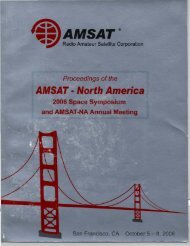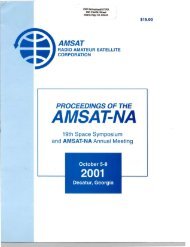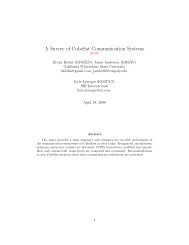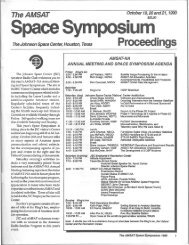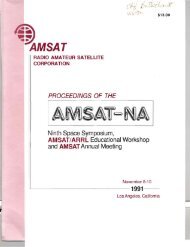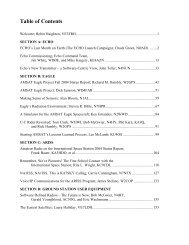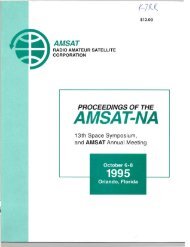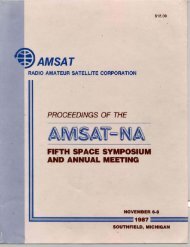October 27-29, 2000 - Klofas.com
October 27-29, 2000 - Klofas.com
October 27-29, 2000 - Klofas.com
You also want an ePaper? Increase the reach of your titles
YUMPU automatically turns print PDFs into web optimized ePapers that Google loves.
A Permanent Amateur Radio Station on<br />
the ISS<br />
Plans for the development of a permanent<br />
amateur radio station located in the habitation<br />
module have also begun. A set of derived<br />
requirements were generated for the<br />
permanent station. These are shown below.<br />
Permanent station derived requirements:<br />
• Eight minute contact with well equipped<br />
ground station<br />
Computer to <strong>com</strong>puter radio links<br />
Thirty second contact with a minimal<br />
ground station<br />
• Autonomous beaconing of status in digital<br />
form<br />
Still picture transmit & receive<br />
Video transmit & receive<br />
Support continuous contacts (for at least<br />
thirty minutes)<br />
• Support multiple concurrent operations<br />
• Space-to-space as well as space-to-ground<br />
operations<br />
Based on these requirements, the NASA ISS<br />
management were briefed on specific<br />
interfaces for the ham station. The briefing<br />
suggested 30 kg of hardware in a standard 19<br />
inch wide rack. The rack-mounted system<br />
would be 24 inches high and would draw 200<br />
Watts ofpower. The station includes external<br />
antennas, and connections to the ISS audio,<br />
video, and <strong>com</strong>puter networks. ISS<br />
management thought these requests were<br />
quite reasonable. A summary of the hardware<br />
described included:<br />
• Multi-band radio support: 10m, 2m,<br />
70cm, & up<br />
External Omni antennas for voice and low<br />
rate data: nadir and zenith<br />
5-25 Watts transmit power; 100 Watt for<br />
ATV<br />
• Flexible TNCs (probably DSP based)<br />
Multiple transceiver systems to support<br />
concurrent operations<br />
• PC interface to the ISS flight <strong>com</strong>puter<br />
systems<br />
• Video processing capability (to support<br />
SSTV and ATV)<br />
• Gained antennas for high data rates<br />
Active station control through the ground<br />
• Pass planning and scheduling software<br />
• Expandability for experimentation<br />
The briefing also suggested external<br />
allocations for four "microsat class" payloads<br />
that could be changed out. This would allow<br />
schools and universities to develop stand<br />
alone payloads and not have to worry about<br />
attitude control, or power concerns. This<br />
allocation has been made on an EXPRESS<br />
Pallet scheduled for a flight in 2004. It will<br />
be incumbent upon the hardware <strong>com</strong>mittee<br />
to rapidly formulate plans to effectively<br />
utilize this space before it gets reallocated to<br />
another project.<br />
Plans for utilizing the externally mounted<br />
payload opportunities of the EXPRESS Pallet<br />
still need to be generated. The initial<br />
EXPRESS Pallet is on the bottom of the ISS<br />
so it provides an ideal Earth view for amateur<br />
radio operations. Each Pallet can hold six<br />
experiment adapters, and ARISS had been<br />
allocated half of one of those, to be shared<br />
with a Jet Propulsion Laboratory optical<br />
<strong>com</strong>munications experiment. The JPL<br />
experiment has been cancelled, and the status<br />
of the ARISS EXPRESS Pallet allocation is<br />
being investigated. Each adapter has a cubic<br />
meter of usable volume and a kilowatt of<br />
power is available on each EXPRESS Pallet.<br />
Plans for utilizing these resources will <strong>com</strong>e<br />
in the form of proposals to the international<br />
hardware <strong>com</strong>mittee. It will be the<br />
responsibility of the international hardware<br />
<strong>com</strong>mittee to evaluate the technical merit and<br />
feasibility of the proposals and generate a<br />
final integrated plan for the ISS. Those<br />
19



